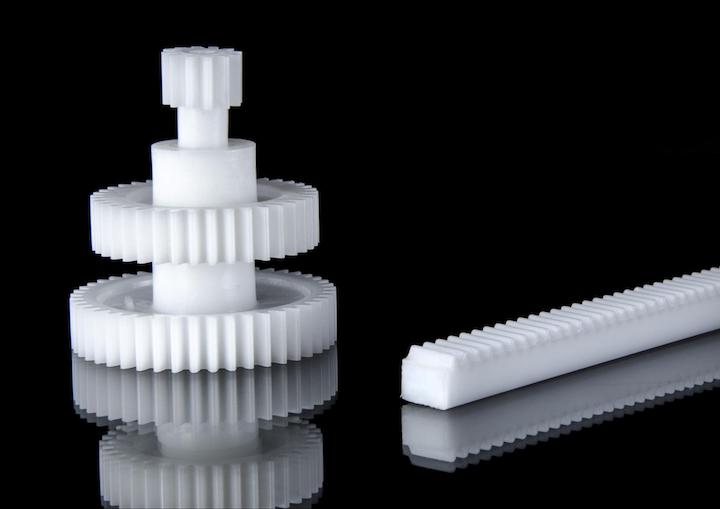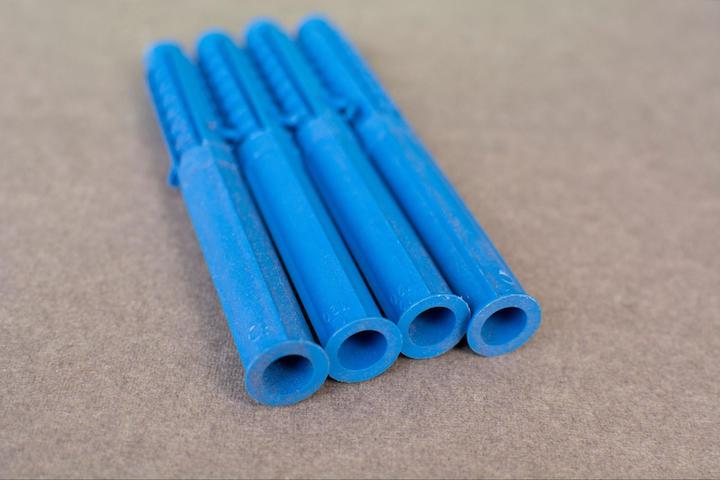Time to read: 6 min
Glass-filled nylon is an engineering plastic that combines the strength and mechanical properties of glass with the versatility of nylon, a thermoplastic that’s used in 3D printing, injection molding and CNC machining. Incorporating glass fibers into the nylon matrix improves strength, stiffness, and durability; however, there are some trade-offs to consider.
In this article, we’ll consider the advantages and disadvantages of glass-filled nylon so that you can evaluate its suitability for your parts. Fictiv helps part designers with material selection and provides free design for manufacturing (DFM) feedback with every quote, so if you’re ready to get started, create a free Fictiv account and upload your designs.

What is Glass-Filled Nylon?
Nylon is a synthetic polyamide derived from petroleum that’s valued for its toughness, chemical resistance, and temperature resistance. It’s used as fibers in textiles, films for food packaging, and resins for manufacturing. Glass-filled nylon, or glass-reinforced nylon, uses nylon as the base material and combines it with short glass fibers that provide reinforcement.
The short glass fibers in glass-filled nylon significantly increase the strength and resistance of this synthetic plastic. The proportion of glass fibers varies and depends on the desired characteristics of the final material — typically it’s 10% to 40% by weight. Glass-filled nylon also comes in different grades and may be based on nylon 6 or nylon 66 formulations.
The incorporation of glass can be achieved through various methods, such as mixing powdered glass particles into nylon resin, integrating small round glass beads into nylon powder, or blending small glass fibers with nylon pellets or filaments during the extrusion process. Blends such as 30% glass-filled nylon 66 are commonly used for plastic extrusion.
How Strong is Glass-Filled Nylon?
The strength of glass-filled nylon varies with the specific nylon formulation and the percentage of glass fibers. Strength is also affected by the type and length of the glass fibers, the distribution of fibers within the nylon matrix, and the overall fiber-to-resin ratio. In general, higher percentages of glass fibers result in greater tensile strength, flexural strength, and impact resistance.
Depending on the specific material composition, glass-filled nylon can have tensile strengths ranging from 50–200 MPa. Flexural strengths can range from 50–300 MPa or higher. To determine the exact strength of a particular grade or type, you should consult the material’s technical data sheet and perform testing with sample parts.
What’s the Difference Between Nylon 12 and Glass-Filled Nylon?
Nylon 12 and glass-filled nylon are two distinct materials with different compositions and properties. Nylon 12, which is also known as polyamide 12 or PA 12, is an unfilled thermoplastic polymer that belongs to the nylon family. This semi-crystalline material offers good mechanical strength, high impact resistance, and excellent chemical resistance.
Nylon 12 also has low moisture absorption, which makes it suitable for use in wet or humid environments, exhibits good dimensional stability, and has low friction properties. Applications for the material span the automotive, aerospace, electronics, and consumer goods industries.
Glass-filled nylon, on the other hand, is a composite made by incorporating glass fibers into a nylon matrix, which makes it a stronger and more durable material than Nylon 12. Glass-filled nylon is widely used in applications that require high strength and rigidity, such as automotive parts, industrial components, and consumer products.

What are the Advantages of Glass-Filled Nylon?
Glass-filled nylon offers seven main advantages over other materials, including unfilled nylon.
- Enhanced Strength and Stiffness: Glass-filled nylon’s higher tensile strength and modulus of elasticity make it suitable for applications that require structural integrity and load-bearing.
- Improved Dimensional Stability: The addition of glass fibers reduces nylon’s coefficient of thermal expansion for greater dimensional stability. In other words, glass-filled nylon is less prone to warping, shrinking, or expansion with temperature variations.
- Increased Heat Resistance: Adding glass fibers to nylon increases the material’s heat distortion temperature (HDT). This enables glass-filled nylon to withstand higher operating temperatures without significant deformation or loss of mechanical properties.
- Enhanced Impact Resistance: Glass-filled nylon can withstand greater impact and has improved resistance to cracking and fracturing. This makes it suitable for applications with dynamic loading.
- Good Chemical Resistance: Nylon has good chemical resistance but glass-filled versions of this material can also withstand exposure to various chemicals, oils, and solvents.
- Excellent Moldability: Glass-filled nylon can be molded into complex shapes and intricate designs. It can be injection-molded with ease and supports cost-effective parts production.
- Electrical Insulation Properties: Like unfilled nylon, glass-filled nylon is electrically insulating. This makes it an option for products with electrical or electronic components.
What are the Disadvantages of Glass-Filled Nylon?
Although glass-filled nylon offers numerous advantages, there are also disadvantages to consider.
- Increased Abrasiveness: Glass-filled nylon is more abrasive than unfilled nylon, so there’s increased wear on 3D printer nozzles, injection molds, and CNC machine tools.
- Higher Cost: Glass-filled nylon tends to cost more than unfilled nylon. Because its added strength and performance come at a higher price, glass-filled nylon may not be cost-effective for some applications.
- More Brittle: Glass-reinforced nylon tends to be more brittle than unfilled nylon. Therefore, it’s more prone to cracking or fracturing under sudden impact or high-stress conditions.
- Added Weight: Glass-filled nylon can weigh up to 15% more than unfilled nylon — a drawback for applications where lightweight parts are a priority.
- Anisotropic Properties: Glass-filled nylon exhibits anisotropic behavior, meaning that its mechanical properties can vary depending on the direction of loading. The alignment of the glass fibers during manufacturing can create variations in strength and stiffness along different axes of the part.
- Moisture Absorption: Unlike Nylon 12, glass-filled nylon tends to absorb moisture, which can lead to dimensional or structural weaknesses in parts exposed to wet or humid environments.

How is Glass-Filled Nylon Used in Parts Production?
3D printing, injection molding, and CNC machining can all produce parts made of glass-filled nylon materials.
3D Printing
There are three forms of 3D printing that use glass-filled nylon materials:
Because of glass-filled nylon’s abrasiveness, hardened steel nozzles are recommended for 3D printing with the material. With SLS, the most commonly used nylon grade is PA 12, which can be reinforced with up to 40% glass fibers, but another option is nylon 3200 glass-filled material. For FDM 3D printing, glass-filled nylon filaments such as nylon 6 (PA 6) with 30% filler are used.
Injection Molding
Plastic injection molding can use various grades of glass-filled nylon materials, including glass-filled nylon 66 with fiber reinforcement ratios ranging from 10% to 50%. Because of the abrasiveness of glass-filled nylon, tools made of harder steels are recommended since these materials reduce injection mold life.
CNC Machining
Glass-filled nylon can also be machined, but the material’s abrasiveness poses challenges. As with injection molds and 3D printer nozzles, CNC machine tools wear more quickly when machining glass-filled nylon. For best results, carbide or ceramic tools are recommended for machining glass-filled polymers, and reducing the cutting speed can also reduce tool wear.
What are Some Applications for Glass-Filled Nylon Parts?
Glass-filled nylon is used in automotive, electronics, and consumer goods applications because of its electrical insulation, high-temperature resistance, strength, and durability. Although glass-filled nylon weighs more than unfilled nylon, this filled material still weighs less than metal and supports weight reduction initiatives.
Examples of glass-filled nylon automotive parts include speedometer gears, engine covers, brake fluid reservoirs, windshield wiper parts, connectors, and wire housings. Consumer goods applications include appliance manufacturing.
Succeeding With Glass-Filled Nylon Parts
Glass-filled nylon is a versatile material that supports 3D printing, injection molding, and 3D printing. But, designers need to consider its advantages and disadvantages during material selection — in addition to strength, factors to consider include cost, exposure to moisture, and weight.
Partnering with Fictiv means you have access to experts in all three manufacturing methods, so you can get material selection guidance plus design for manufacturing (DFM) assistance to ensure your parts work how you need them to.
To get started, create your free Fictiv account and request an online CNC quote today. We make complex glass-filled nylon parts at ridiculous speeds!










